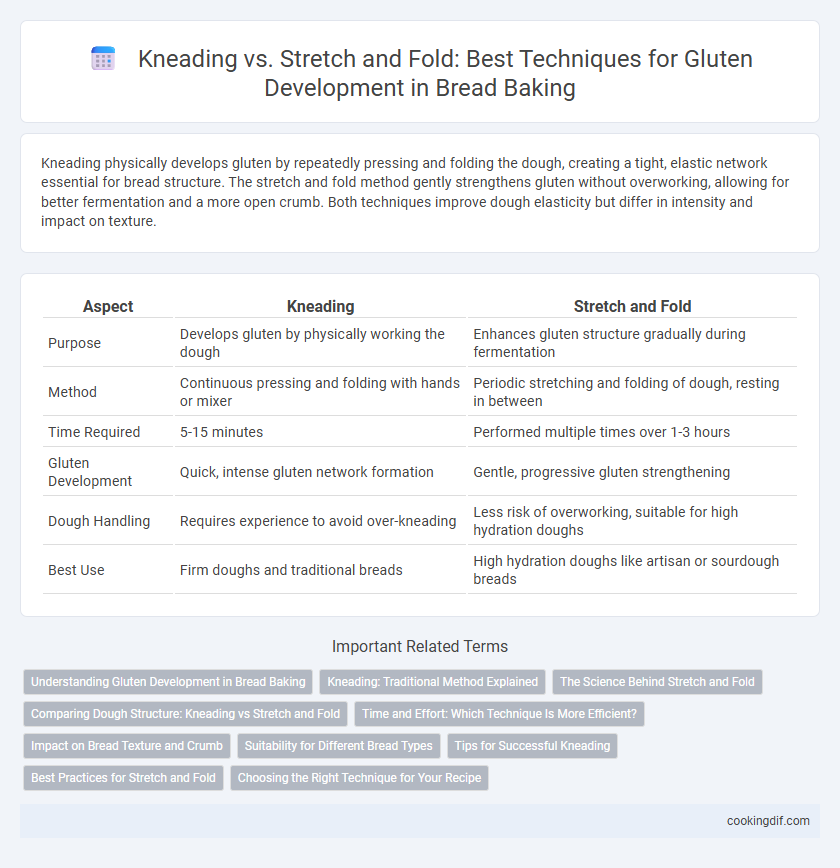Kneading physically develops gluten by repeatedly pressing and folding the dough, creating a tight, elastic network essential for bread structure. The stretch and fold method gently strengthens gluten without overworking, allowing for better fermentation and a more open crumb. Both techniques improve dough elasticity but differ in intensity and impact on texture.
Table of Comparison
| Aspect | Kneading | Stretch and Fold |
|---|---|---|
| Purpose | Develops gluten by physically working the dough | Enhances gluten structure gradually during fermentation |
| Method | Continuous pressing and folding with hands or mixer | Periodic stretching and folding of dough, resting in between |
| Time Required | 5-15 minutes | Performed multiple times over 1-3 hours |
| Gluten Development | Quick, intense gluten network formation | Gentle, progressive gluten strengthening |
| Dough Handling | Requires experience to avoid over-kneading | Less risk of overworking, suitable for high hydration doughs |
| Best Use | Firm doughs and traditional breads | High hydration doughs like artisan or sourdough breads |
Understanding Gluten Development in Bread Baking
Kneading develops gluten by mechanically aligning and strengthening gluten strands through continuous pressing and folding, resulting in a uniform and elastic dough structure. Stretch and fold technique gently strengthens gluten networks by periodically stretching the dough and folding it over itself, enhancing gas retention and dough extensibility without overworking. Both methods contribute to optimal gluten development, essential for creating bread with ideal texture and crumb.
Kneading: Traditional Method Explained
Kneading is a traditional method of gluten development where dough is pressed, folded, and stretched repeatedly to align gluten strands, resulting in a strong, elastic network crucial for bread structure. This technique enhances dough extensibility and gas retention, producing a consistent crumb and chewy texture typical in artisan breads. Mastery of kneading time and pressure directly influences the dough's rise and final loaf volume.
The Science Behind Stretch and Fold
The stretch and fold technique promotes gluten development by gently aligning gluten strands without overworking the dough, preserving gas bubbles crucial for fermentation. This method maintains dough hydration and elasticity, optimizing gluten network formation compared to traditional kneading. Scientific studies show that stretch and fold enhances dough strength and extensibility, resulting in improved texture and rise in artisan bread.
Comparing Dough Structure: Kneading vs Stretch and Fold
Kneading develops dough structure by continuously aligning gluten strands through vigorous, repetitive motions, resulting in a tight, elastic crumb ideal for traditional bread. Stretch and fold method gently strengthens gluten by periodically stretching and folding the dough during fermentation, producing an open crumb with a lighter, airier texture. Both techniques enhance dough strength, but kneading excels in rapid gluten development while stretch and fold promotes extensibility and gas retention.
Time and Effort: Which Technique Is More Efficient?
Kneading develops gluten by continuous, vigorous pressure, typically requiring 10-15 minutes of hands-on effort to achieve a smooth, elastic dough. The stretch and fold method uses intermittent gentle stretches and folds over time during bulk fermentation, reducing physical exertion while allowing gluten to develop gradually over several hours. For efficient gluten development with less manual effort, stretch and fold is preferred, especially in artisan bread baking.
Impact on Bread Texture and Crumb
Kneading develops gluten through continuous dough manipulation, resulting in a tight, uniform crumb with a denser texture ideal for sandwich loaves. Stretch and fold promotes gluten strength more gently by folding the dough at intervals, creating an open crumb structure with larger, irregular holes characteristic of artisan breads. The choice between methods directly influences bread texture, with kneading producing firmer, more elastic crumb and stretch and fold yielding lighter, airier results.
Suitability for Different Bread Types
Kneading is ideal for breads requiring strong gluten networks like bagels and artisan loaves, as it promotes thorough gluten alignment through continuous pressure and movement. Stretch and fold suits high-hydration doughs such as ciabatta and focaccia, preserving dough structure while gently developing gluten without overworking. Both techniques optimize gluten development but cater to different hydration levels and bread textures, influencing crumb density and chewiness.
Tips for Successful Kneading
For effective gluten development during kneading, apply consistent pressure with the heels of your hands while folding the dough back onto itself, ensuring even texture and elasticity. Use a lightly floured surface to prevent sticking without incorporating excess flour, which can toughen the dough. Maintain a moderate pace and avoid over-kneading, as this can break down gluten structures and negatively affect bread rise and crumb.
Best Practices for Stretch and Fold
Stretch and fold is a preferred technique for gluten development in bread dough, especially with high hydration batters, as it gently aligns gluten strands without overworking the dough. Best practices include performing multiple stretch and fold cycles at 20- to 30-minute intervals during bulk fermentation to improve dough strength and elasticity while preserving air bubbles. This method enhances gas retention and crumb structure, producing a light, open texture in artisan breads.
Choosing the Right Technique for Your Recipe
Kneading develops gluten by applying continuous pressure and stretching, creating a smooth, elastic dough ideal for traditional bread like baguettes and sandwich loaves. Stretch and fold is a gentler technique that maintains dough structure while incorporating air, perfect for high-hydration doughs such as artisan sourdoughs. Selecting the right method depends on the hydration level and desired crumb texture, with kneading suited for dense, uniform loaves and stretch and fold enhancing open crumb and complex flavor.
Kneading vs Stretch and Fold for gluten development Infographic

 cookingdif.com
cookingdif.com